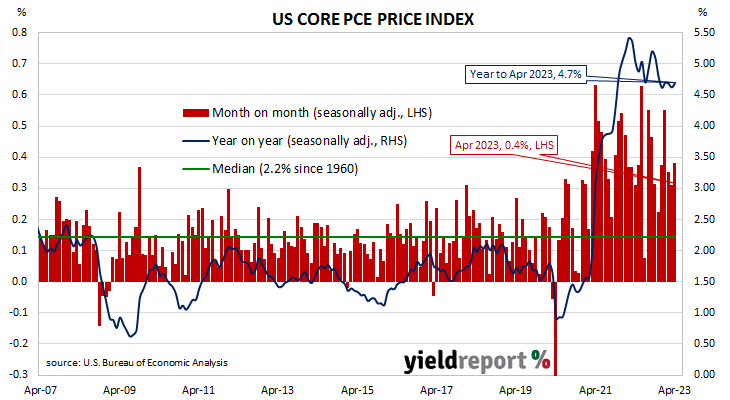Summary: US core PCE price index up 0.4% in April, in line with expectations; annual rate accelerates from 4.6% to 4.7%; NAB: deflater indicates “little progress” on inflation fight; short-term Treasury yields rise; Fed rate-cut expectations for 2024 soften.
One of the US Fed’s favoured measures of inflation is the change in the core personal consumption expenditures (PCE) price index. After hitting the Fed’s target at the time of 2.0% in mid-2018, the annual rate then hovered in a range between 1.8% and 2.0% before it eased back to a range between 1.5% and 1.8% through 2019. It then plummeted below 1.0% in April 2020 before rising back to around 1.5% in the September quarter of that year. It has since increased significantly above the Fed’s target.
The latest figures have now been published by the Bureau of Economic Analysis as part of the March personal income and expenditures report. Core PCE prices rose by 0.4% over the month, in line with expectations but higher than March’s 0.3% increase. On a 12-month basis, the core PCE inflation rate accelerated from March rate of 4.6% to 4.7%.
“The core PCE deflator continues to show little progress on the current phase of the inflation fight,” said NAB economist Taylor Nugent. “In 3 month-annualised terms, the core PCE deflator is 4.3%, the same rate it was a year ago in April 2022.”
Short-term US Treasury bond yields rose on the day, while longer-term yields fell. By the close of business, the 2-year Treasury bond yield had gained 3bps to 4.56%, the 10-year yield had lost 2bps to 3.80% while the 30-year yield finished 4bps lower at 3.96%.
In terms of US Fed policy, expectations of lower federal funds rates in 2024 softened. At the close of business, contracts implied the effective federal funds rate would average 5.16% in June, 8bps higher than the current spot rate, and then move up to average 5.25% in July. September futures contracts implied a 5.315% average effective federal funds rate while May 2024 contracts implied 4.475%, about 60bps less than the current rate.
The core version of PCE strips out energy and food components, which are volatile from month to month, in an attempt to identify the prevailing trend. It is not the only measure of inflation used by the Fed; the Fed also tracks the Consumer Price Index (CPI) and the Producer Price Index (PPI) from the Department of Labor. However, it is the one measure which is most often referred to in FOMC minutes.


